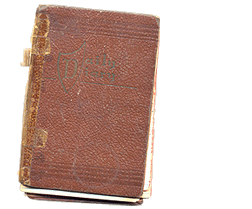
BOMB EXPLOSION WILL MODERNIZE CHICAGO DRAMA: The atomic bomb explosion and V-J day will be dramatized when “Port of Chicago” is presented by the Uptown players, 1219 N. La Salle st., every Friday and Saturday night during October. --Chicago Tribune
In the course of searching for information in the Tribune about the Uptown Players or the “Port of Chicago” play they were staging in September of 1945, I came across this, tragic item from April 21, 1946:
500 FLEE FIRE; ACTRESS CALMS THEATER CROWD; Two on Upper Floor Are Rescued: Five hundred persons fled a fire last night in the Uptown Players theater, 1219 N. La Salle st., in an old four story building. The interior of the building, formerly a church, was destroyed. For a time, the fire threatened the 18 story Marquette apartments, 1211 La Salle st.
This in turn led me to an interesting story concerning S.D. Records and a jazz records collector named John Steiner, the course of whose life was changed by the Uptown Players Theater fire:
S D Records was the brainchild of two Chicago record collectors, John Steiner and Hugh Davis. As with most collector jazz labels of the period, S D focused on reissuing vintage jazz recordings from the 1920s and 1930s and new recordings either by artists from that period or by younger artists who played in a traditional style.The company was founded in January 1944, but Steiner and Davis had already been working together for four years, recording music in the city at various homes and on location in clubs.The label's original headquarters were at Steiner's home, at 104 East Bellevue Place. Steiner and Davis departed from usual business model for a collector label: they did not operate a record shop to help support it, although both bought and sold extensively in the collector market.But in June 1947, when S D was no longer making new recordings but was continuing with its release program, the company's headquarters moved to Chicago's downtown, at 8 South Dearborn. There Steiner operated a "record exchange," essentially a record shop for rare jazz discs.
The partnership after which the label was named survived barely more than a year: in February 1945 Davis sold his half of the company to Steiner (the transaction was announced in Down Beat on February 15).Steiner operated the imprint on his own for the next five years. Because of the trouble they were having, getting pressings of reasonable quality at an affordable price, Steiner and Davis had already quit pressing S D 78s in the fall of 1944; a Down Beat item on January 1, 1945 announced that S D was suspending activities "until conditions return to normal."In mid-1945, the dormant company's address changed to 1225 North Lasalle; i.e., the Uptown Playhouse Theater, where Steiner was actually living while promoting trad jazz concerts and operating other ventures. But Steiner was compelled to regroup after the theater burned down on April 20, 1946.
There was another significant hiatus in Steiner's activities after a disastrous fire hit the Uptown Playhouse Theater on April 20, 1946.In his rueful post-mortem, "Records to Burn," he noted that the fire began as the Players were finishing the third act of "You Can't Take It with You."
It reduced the building to a shell. "Along with theater properties were consumed my library and clothes, furniture and office equipment, substantially all of the thousands of records racked in the phono-storage room, the recording studio (more destroyed by inundation than by fire), and every piano in the place, including my upright autographed with the sharp corner of a screw-driver by a host of visitors from Yancey to Slam."
Along with pressings of previous S D releases (but fortunately not their masters) Steiner lost no less than 150 unissued sides by Jack Gardner and his groups (Steiner refers to Gardner as the "musical director for S. D. enteprises since 1941"), 20 sides by groups led by Boyce Brown, a few by Frank Melrose, and location recordings by Gideon Honoré, Zinky Cohn, Punch Miller, Bobby Hackett, Joe Sullivan and Jimmy Yancey, along with many disks recorded from radio broadcasts by big name jazz artists.
Taking the chemist's analytical attitude, Steiner noted that when the 78s were inundated, the labels peeled right off the records pressed during World War II while sticking fast to the pre-war Decca, Columbia, and Victor product."Wartime shellac compositions blistered upon long contact with dirty water and they became raspy under the needle... A few records of recent pressing, including some Savoy, Philo, and Keynote, after five days immersion, crumbled like clay pies, presumably due to solution of some element in their composition."
"There may be some gain from this experience, especially if this story carries a moral. Records are not to be stored in inflammable buildings. Records are to be copied and the copies widespread".
No doubt helping his recovery from the fire, Steiner was able to get in another recording session. On September 30, 1946, he conducted a marathon outing involving tenor saxophonist Bud Freeman and alto sax player Bill Dohler; Jack Gardner and Tut Soper took turns at the piano bench. Three S D 78s were drawn from it; they were released in March 1947, marking a return to activity for the label.
The 18-story Marquette Apartments--now the LaSalle Towers Condominiums--at 1211 N. LaSalle, which narrowly escaped fire damage, still stands today, and is familiar for the large, three-dimensional mural on its wall.
Steiner's former home at 104 East Bellevue Place, just a block from the lakefront, is gone, replaced by a tall condo building.
Baby Dodds was one of the jazz artists whose records Steiner was thankfully able to re-press. You can listen to some of Dodds' work here.


No comments:
Post a Comment